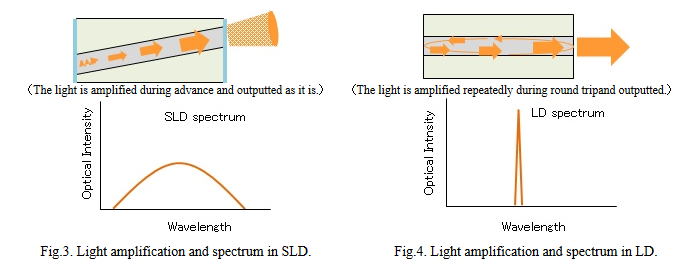JAPANESE / ENGLISH

JAPANESE / ENGLISH
Last updated on 05/7/2021
The SLD (Superluminescent Diode) is a semiconductor device to emit low-coherence light of a broad spectrum like LED (Light Emitting Diode), but high brightness like LD (Laser Diode). Light emitted in a narrow active layer similar to LD can be efficiently incident to the fiber. SLD is commonly used as incoherent light source for optical sensors like OCT and optical fiber gyroscopes.
The mechanism of SLD emission is the same as semiconductor laser (LD) and light emitting diode (LED). Emission occurs by flowing forward current to a p-n junction. When a power supply is connected to the p-layer positive and the n-layer negative, electrons enter from the n-side and holes from the p-side. When the two meet at the junction, an electron drops into a hole and light is emitted.
The difference between the SLD and LD is presence or absence of the end surface reflection. The structure of the SLD is almost the same as LD. Figure1 shows the structure of SLD and LD. In the both devices, the active layer (light emission layer) sandwiched between the p- and n-type clad layers (double heterostructure) is formed on an n-type substrate, and voltage is applied across the p-n junction from the electrodes. The difference is whether the light is reflected at the end surface of the active layer. While the SLD has the AR-coated end of the active layer to prevent reflected light, the both end surfaces of the LD is cleaved to form Fabry-Perot resonator.

Figure 1. Structure of SLD and LD
For a further reduction of the light reflection at the end, the angled waveguide is formed as shown in Fig. 2. In this way, the light is diagonaly reflected at the end, and the reflected light is leaked outside the waveguide.

Figure 2. Angled waveguide structure SLD
The difference between the SLD and LD is the presence or absence of the reflection at the ends. As a result, they emit the light with different properties. In the case of the SLD, as shown in Fig.3, the spontaneous emission light is amplified by stimulated emission during the advance through the active layer, and is outputted as it is. The light is called superluminescence and is the same type of light emitted from the rare earth doped fiber referred to as ASE light. Since the spontaneous emission light as a seed light has a random phase and a broad spectrum, the superluminescence also becomes a low-coherence light with a broadband spectrum. On the other hand, the light of LD has a very specific wavelength and phase, because it is reflected at the end surfaces to reciprocate through the active layer as shown in Fig.. Thus, coherent laser beam with a narrow spectrum is generated.

The emission wavelengths of the SLD depend on the band gap energy of the semiconductor as in the case of LD and LED. A semiconductor with a larger band gap emits a shorter wavelength. For example, an AlGaAs emits wavelengths of 0.8 ~0.9 μm , and a GaInAsP with a smaller band gap emits longer wavelengths of 1.3~1.6 μm. In some cases, emission of broader wavelengths is required for the SLD. For this purpose, there is a case that the semiconductor composition is gradually varied in the longitudinal direction of the active layer.
FiberLabs offers the following products related to this article. Please visit these pages if you are interested in this article.